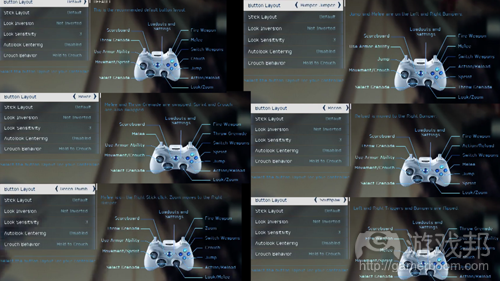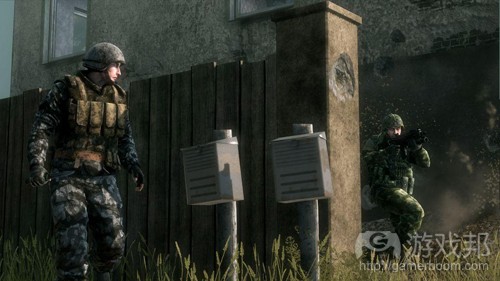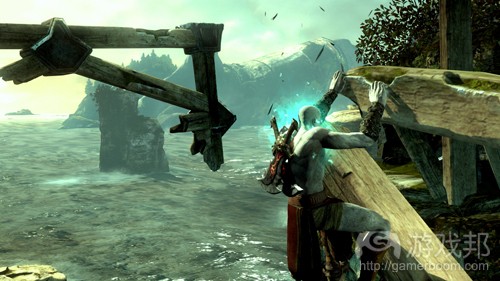阐述人们玩游戏的失误类型及其作用
作者:Ben Lewis-Evans
玩游戏经常是一个犯错的过程。我们虽然贵为伟大的人类,却总是犯错,在玩游戏时,我们总是难免接受一定程度上的错误,只能尽量最小化或减少错误。错误有多种形式,Rasmussen所提出的“技能-规则-知识”框架,以及Reason撰写的文章揭示了其中之一。
这个框架的一个层面是“技能”,技能是我们生活和玩耍中最为自发的一种形式(游戏邦注:有时候也被称为“肌肉记忆”,或更准确地称为“程序记忆”)。例如,你在《街霸》中无需思考如何移动手指,摁压哪个按钮就能启动一个火球,或者你在MOBA中无需思考时机就能投出最后一击。此类情况下发生的失误是最普遍的一种失误,因此理解失误最可能在何时发生会对设计游戏体验很有帮助(游戏邦注:用于避免错误,以及利用错误为游戏引进新挑战)。
在切入正题之前,我想澄清一点,本文重点并非引导开发者如何清除游戏中的错误行为。毕竟游戏中总会发生多种意外情况,无法令玩家完全操作无误地完成游戏。游戏通常都是一种挑战,因此了解错误及其成因不但有助于通过减少错误概率而提高用户体验和易用性,而且还可以通过增加错误来优化游戏设计和游戏挑战。因此,我将首先列出错误的类型,然后针对每种错误分别举例,指出开发者应该减少或增加的错误类型。
技术层面:疏忽和失误
简单而言,这两者的区别在于,疏忽是指肢体操作的直接错误(游戏邦注:例如,你很自然地去摁压X按钮,而实际上你本想摁压O按钮),而失误则是指大脑操作错误(例如,你因为嚷嚷着让小猫别挡着屏幕,而忘了在开启《使命召唤》下一款游戏前必须更改装备设置)。这就是两者的差异,但关键在于这两者为何以及何时发生。现在让我们再看看失误类型的两大分组。
疏忽造成的错误——“对不起,我没有注意到”
因疏忽或没注意而产生的错误同玩家所具有的注意力,以及特定时间所发生的事情有关。所以,经常会发生某人由于超负荷或分心而产生的错误。这些错误可以进一步分解成多种疏忽错误类型:
双重分心失误——“为什么我会在《生化奇兵》的自动贩售机之前上上下下跳个不停?”
双重分心失误就是,你分神了或者超负荷时,你执行通常所习惯的操作时可能会脱离你预期的范围。例如,假如你正在玩一款MOBA或RPG游戏,你通常会将药品道具放在特定的装备插槽中,然后摁压与之相关的按钮,令药物的治疗功能自动生效。但是,如果该插槽在某个时候正好塞了另一种道具,并且因为身陷一场大型战役而恐慌或分心(你的注意力转移到其他地方),你可能会发现自己摁压了与治疗道具相关的按钮,即使它并不存在。这种错误通常很明显,虽然有时候它总会人懊恼不已“我摁压了该死的治疗按钮!为什么它还不奏效!?”另一种常见情形是你已经玩过某种题材的大量游戏,比如说在一款FPS中使用A按钮进行跳跃。然后你玩的另一款FPS是使用A按钮来同游戏世界中的物体互动。此时你就会发现,自己会在无意识中用错按钮,在不想跳跃时跳跃,在不想与物体互动时进行了互动。
*减少错误:尝试用设计来设置环境线索,以便让玩家清楚此时的情形已经不同以往。要保持一致性。如果玩家在你的游戏中不得不反复动用特定技能或者按钮,就要注意他们可能会形成一种在类似情形中自动使用该技能/按钮的习惯。所以,你若要更改该按钮/技能的用途,或游戏世界与之互动情况,那就要多留意了。如果你是想让自己的游戏和同个题材的类似游戏操作标准化(例如,让治疗道具仅能放置于治疗插槽;右击进行移动,左击进行选择),那么这或许是个很有帮助的做法。如果你的游戏类型存在一些标准化的控制方式,那就考虑采用这些标准(或者将其作为一种选项)(游戏邦注:例如,《光晕》或《使命召唤》控制方案就成了主机FPS游戏的标准)。除此之外,你还可以考虑让玩家自定义控制方式。
*鼓励错误:培养玩家习惯。让玩家反复执行一种操作。或者采用玩家可能在其他游戏中培养的习惯。然后将其载入自己的游戏,并更改该操作的结果,使之无法在自己的游戏中产生以往的“正确”表现。从根本上说,就是培养反应模式,然后更改该模式。转换战斗中的目标控制方式(例如《死亡空间》的最终boss战役)就属于鼓励这种错误类型的典型,它有效地促使玩家在紧张的情形下同根深蒂固的自发倾向作斗争(如果他们像我一样懒,就可以暂停游戏,返回原来的“标准”控制方式)。
受干扰而产生的疏忽——“我确信自己真的保存了这些调整……”
因干扰而产生的疏忽是指你开始做一件事,停下来做另一件事,然后又返回第一个任务,并跳过了原先执行该任务所需的一个(或几个)步骤。例如,你一开始是在个性游戏中的技能树,但却被一则关于你已经解琐了一款新武器的通知打断了(或者突然想起这则通知),你就会去查看新武器或者选择忽略该通知,然后返回你的技能树,但却忘了你之前准备干什么了(或者忘了保存你更改的设置)。你需要一定时间才会发现这类错误。这是因为这类疏忽的一个特点就在于,你跳过了一个步骤,并认为自己已经完成了某事。除非跳过这个步骤会产生一种直接的后果,不然你一般难以发现自己犯的错误。
*减少错误:要确保玩家没跳过重要的步骤,减少一些重要多步骤任务中不必要的干扰,设置为玩家进行检查的软件(确保突出和确认重要的决策。例如,使用退出守卫检查你是否保存了更改,如果你跳过了这个屏幕保存就会丢失),你甚至可以减少多步骤任务的数量(例如,减少多任务处理)。通常来说,增加直接后果或遗忘重要操作的提示即可。制定一些宽容的决策也会有用处,例如允许使用技能回顾,使用良好的检查点,或者允许手动保存。
*鼓励错误:一次给玩家分配许多任务。尤其是在他们执行其他任务时插入新任务;不要为玩家提供任何帮助他们记忆或提醒遗漏步骤的线索。
(如果你在《动物之森》中忘了保存,Mr.Resetti 就会蹦出提醒玩家忘记保存的后果。)
因延时而失控——“啊,Arathi高地……为什么我会在这里?”
因延时而失控是一另项熟悉而令人抓狂的错误。这是指在你开始打算做某任务以及真正开始执行任务之间的间隔时间,因为这种延时导致出错的情况。这方面的例子就是在游戏中的锻造地点,发现自己并没有足够的
资料制作某项道具。所以你就要启程去其他地方寻找所需材料,但你拼命赶到那里时,却已经不记得自己到此的目的究竟是什么。有时候这种表现形式包括“我来这里干嘛?”,“我应该在这做什么?”或者更糟的是“我好像要做什么,但是想不起来了。”这种错误发生的一个原理是改变你原来所处的环境,移除提醒你执行最初任务的相关线索。所以在以上例子中,你站在自己的锻造室中会寻找尝试使用的配方。但当你走进外面的世界,这种提示就消失了,再加上你是自主导航,你就很难回忆起自己当初究竟在找什么。另一个例子是在冒险游戏中,重返原来访问过的区域寻找某一物品,但你却不记得该物品究竟身处何地,或者你返回原地时却忘了自己到来的原因。
*减少错误:通过使用任务记录、日志、提示、地图标记等,让线索更具可视性。一般来说,可以在游戏世界中使用提示或支持系统来告知玩家所需执行的事项。甚至还可以避免使用需要玩家长途跋涉,去不同地点或需要花费大量时间才能执行操作的任务。
*鼓励错误:将任务分配到多个地点,但要限制关于如何执行任务或到达特定地点的引导(例如,在墙上留下的标注以及一小段对话)。确保玩家准备执行任务开始及其结束之间相隔多时,确保这两个节点之间还发生了其他事件。要求玩家原路返回其他地点,但却不提供足够想起这些地点的线索。
认知错乱-—–“糟糕!点击错了!”
另一个普遍现象就是认知错乱,这是指当至少两件相似的东西出现时,你的大脑瞬间把两者混淆了,做出了错误的选择。例如,偶然间错把队友当敌人而发弹射中了对方。
*减少错误:为游戏世界中其他玩家、敌人、按钮和重要道具、物品设置独特的外形和轮廓。要用高光显示对当前游戏玩法尤为重要的道具/物品/人物/地点(如果它们现在不重要,就不要给予高光显示)。
*鼓励错误:让物品看起来极为相似,除非玩家仔细检查才能看出破绽。然后让玩家置于重荷或者分心状态。例如,让身处仓库的玩家一边同坏蛋过招,一边寻找某个特定的板条箱,或者按下闪光、相似外观的按钮,在特定时间限制内输入一个代码。
(俄罗斯和美国部队之间有何明显区别?你能否在一定距离内发现这一点?是否想让玩家混淆起来并误伤盟友?)
干扰性错误——“你在Hinterlands干什么?我说了我们是在Aeris码头而不是Aerie公园见面。”
干扰性错误通常被称为“弗洛伊德口误”(说溜了嘴的错话,你想说这事,但脱口的却是另一回事)。这就好像是你自己思考过程中的认知错乱,因为有两件或更多在认知上存在联系的东西在你脑中混淆起来(这些东西有可能是发音相同,也可能只是与同一个任务相关)。这也可能由你所在环境的强烈信息提示/吸引注意力的物件干扰而产生,例如,有些吸引你的眼球或者突然弹出的东西与你当前的思考过程相混合。注意,虽然这些是意识模糊,但仍可能产生行为结果,例如在奇幻游戏环境中走向两个发音非常相似的地点,或者在RPG中错买了另一把斧头。
*减少错误:用与认知混乱的相似手法,确保使用独特的理念和术语,避免玩家信息超载(这在需要玩家掌握大量新术语的科幻或奇幻游戏世界中更是如此)。此外,还要避免不处要的多重任务以及在任务中间插入不必要的信息。允许玩家使用聊天宏指令来减少流入常用交流命令的干扰错误(例如,在MOBA游戏中有人本想说“到中间去”结果却说成“到底下去”——他们说话的时候可能正好看着中间,或者在想着自己必须到中间去)。
*鼓励错误:在游戏中大量使用外观或发音相似的物品名称。此外,还要让玩家在面临压力的情况下记住名称相似,或者功能上互有关联的的术语/信息。
过度关注错误——“跟紧目标,跟紧目标”
提到犯错,人们通常想到的是因疏忽而犯错。这一点情有可原。但很少人会想起过于关注某一任务也会犯错。想想看,当你在玩一款游戏时,你一直都很顺利地跳跃,执行所需的各项操作,但突然犯了一个错误,又返回了关卡开始之初。之前辛苦做的一切都付之东流。此时你会想“是时候集中精力再试一次了”(除非你无法执行该操作),之前你能够轻松完成的跳跃此时却突然变得极具难度。这是因为你投入了太多注意力,导致过犹不及,无法完成一个之前很熟悉的任务。
一般来说,自发技能行为意味着我们可以无需大费周章地完成复杂的任务。事实上,我们的日常生活,更不要说是玩游戏,都在不可避免地塑造和使用自发技能。但是,当我们集中精力试图再次做我们本可以做到的事情时,就需要投入“更高”层次的认知过程,而这又需要我们投入更多精力,并且无法处理我们之前能够轻松摆平的干扰和分心情况。这意味着你此时已没有能力像之前一样妥当执行任务。除此之外,这种“更高”层次的认知过程还会碍事,带来其自身存在的偏差和失误。
这种情况发生的另一原理在于,当你集中精力试图避免做某事时(例如略过一次跳跃),却会讽刺地发现自己很可能做了这事。原因在于,你努力去提醒自己一定不要做某事时,往往很可能激活你大脑中与该事件相关的区域,而如果你已经超载了与(你想避免的)该动作相关的自发操作模式,这一动作却会突然蹦出并控制你的操作(就好像有人告诉你不要去想白熊,一定不要去想!你反而就是会想到白熊!)在《黑道圣徒》等开发世界游戏中可以看到这种“反话过程”现象,在紧张的追击过程中,当你试图避免撞到其他车子时,却总会撞到障碍物。但之后当任务要求你真的去撞击特定车子或目标时,你反而频频失手,尽管你应该去撞击的目标与之前试图避开的物件并无区别。在这种情况下,你过度关注反而会让你更难以完成预想的操作,更容易去做极力想避免的事情。
*减少错误:根据心流状态而设计游戏。让玩家进入一种无需费神,并且能够畅通无阻地完成任务的状态。但是,如果这种心流状态被打断,就会开始产生一个犯错循环,此时就要让玩家暂停片刻,或者切换到其他活动。建议此时让玩家去尝试新玩法模式或目标。这样可以让他们缓口气,不再纠结于之前的任务到底出了问题。也许你还会建议让玩家休息一会儿,并让一名绝世高人为其指点迷津。你还可以允许玩家跳过该游戏环节,或者降低其难度水闰,不过,这种做法在某些情况下可能会适得其反,它会让玩家更加纠结于自己的失败。
*鼓励错误:将复杂的交互系统(重叠和混合相对简单的自发技能)抛给玩家。让他们执行繁多而互不相容的任务。要用文本指出他们容易出错的地方,或者点出其他吸引他们有意识处理的信息,让他们清楚地思考自己的操作行为。让他们知道自己得努力尝试。
(你已经连续20次跳跃失败了,你太逊了,需要我降低游戏难度吗?)
总结
人类难免犯错。如果我们都不犯错,游戏就会陷入无趣的境地。看看这些错误和“技能”水平,会发现它们存在两种主要类型。一种是由于太不上心而造成,一种却是因为对一些相对简单、通常可以自发完成的任务太在意而造成。你可以通过减少这些错误发生率避免其干扰游戏(例如,在界面设计和使用方面下功夫),但与此同时你还可以利用这些错误来增加游戏的挑战性和难度。
我的上述建议也许只能算是陈旧的易用性或用户体验指导原则。但是,我并不认为牢记易用性和用户体验概念有什么坏处,因为这不但可以让你的游戏更有难度(或者更具挑战性和好玩),还可以让游戏体验更为顺畅(或者还会更有趣)。(本文为游戏邦/gamerboom.com编译,拒绝任何不保留版权的转载,如需转载请联系:游戏邦)
Human error and games – Reducing, and taking advantage of, slips and lapses
by Ben Lewis-Evans
The following blog was, unless otherwise noted, independently written by a member of Gamasutra’s game development community. The thoughts and opinions expressed here are not necessarily those of Gamasutra or its parent company.
Want to write your own blog post on Gamasutra? It’s easy! Click here to get started. Your post could be featured on Gamasutra’s home page, right alongside our award-winning articles and news stories.
Playing games is often an exercise in error. We, as wonderful humans, make errors all the time, and when it comes to games we try to perform while accepting a certain level of error (i.e. I cleared that level, I got hit 20 times, but I didn’t die, so time to move on) or, if so inclined, work to minimise or eliminate error (i.e. perfect runs). Errors come in many shapes and forms but the ‘Skill-Rule-Knowledge’ framework of Rasmusssen and the writings of Reason gives us one way to look at them [1].
One aspect of this framework is ‘Skills’, skills being the term for the mostly automated way that we go about our lives and our play (sometimes also called ‘muscle memory’ or, more accurately, ‘procedural memory’). This is where you can launch a fireball in Street Fighter without thinking about how your fingers have to move and which button you have to press, or last hit in a MOBA without having to consciously work out the timing. Errors that occur at this level are the most common type of error, and therefore an understanding of when they are likely to happen could be useful when designing gameplay experiences (both to prevent these errors and to take advantage of them in terms of introducing challenge in a game).
Before going on, I want to make clear that this blog post isn’t just about removing error from games. There are many situations in games where players shouldn’t be breezing by error free. Games are often about challenge, and as such knowing about errors and how they occur is not just useful for user experience and usability in terms of reducing the likelihood of error, but also could be useful from a game design standpoint for increasing errors and therefore the challenge of a game. As such, in the sections below I will first outline the error type, and then for each error type give a few examples of how, perhaps, the likelihood of particular error type mentioned occurring could be reduced or encouraged.
A technicality – Slips vs Lapses
A first distinction that can be made is to split these, automatic mostly unconscious, types of errors into Slips and Lapses. Simply put, slips are when a physical action goes directly wrong (i.e. you automatically press the “X” button without thinking when you meant to press the “O” button) and lapses are where a mental action goes wrong (i.e. you forget to go change equipment loadouts before starting your next game of CoD because you were shouting at your cat to stop attacking the screen). Ok, so that is the distinction. Fine, but what really matters is why and when either a slip or lapse occurs, so let’s get to that. Again, here there are two major groupings.
Errors of Inattention (or Omission) – “Sorry, I wasn’t paying attention”
Errors of inattention or omission are related to how much attentional capacity your player has (a limited resource) and what is going on at any particular time. So, basically, these are errors that occur because someone is overloaded or distracted. These errors can be further broken down into several types of errors of inattention:
A double capture slip – “Why I kept jumping up and down in front of vending machines in Bioshock”
A double capture slip is where you are distracted and/or overloaded, running on automatic, and the behaviour that you would usually do in a certain situation takes over rather than the behaviour you intended to do. So, for example if you are playing a MOBA or a RPG and you usually put a healing item in a certain equipment slot. Then pressing the button related to that slot in situations where you need healing will become relatively automatic. However, if you get into a situation where you happen to have another item in that slot and are panicked and/or distracted in the middle of a big fight (your attention is captured in other words) you may find yourself automatically hitting the button that is usually associated with the healing item, even if it is not there. This type of error is usually pretty immediately clear, although sometimes it does lead to an “I am hitting the stupid heal button! Why isn’t it working!?” type of confusion Another common situation is where you have played a lot of one type of game in a genre, for example a FPS that uses the “A” button for, say, jumping. Then you play another FPS that uses the “A” button for interacting with things in the world. What you will find is that without thinking about it that you will sometimes get in the frustrating situation of jumping when you don’t want to jump and interacting when you don’t want to interact.
Error reduction: Try to use design to setup environmental cues that make it very clear that a situation has changed from the norm. Be consistent. If a player has had to use a certain skill or button over and over and over in your game expect that they will have a tendency to automatically use this skill/button in appropriate situations (great, you want this generally), so think about it if you are going to change what that button/skill does or how the game environment interacts with it. This can be helped by keeping things standard (i.e. only healing items go in the healing slot) both within your game but also between similar games in the genre (e.g. right click to move, left click to select). Also if there are controls that are pretty standard for your type of game think about using them (or including them as an option) (i.e. the Halo control scheme or the CoD control scheme for FPS games on consoles) While you are at it, for accessibilities sake as well, consider letting the player customise their own controls.
Error encouragement: Establish habits. Get players to do an action over and over and over again. Or use habits that gamers may have picked up from other games. Then place them under load and change what that action does or the situation so that performing that action is no longer the correct thing to do. Basically, establish patterns of responding, then change that pattern (a classic Simon Says trick). Inverting the aim controls in a battle (such as the final boss in Dead Space) would be an example of encouraging this type of error in that you are effectively forcing the player to fight against their ingrained automatic tendencies while in a stressful situation (or, if they are lazy like me, pause the game, go into the controls and invert the controls so that they are “inverted” back to normal).
Oh bumper jumper, I dare not try you as if I liked you, you would ruin me forever in other games
An omission following interruption – “I’m sure I saved those changes…”
An omission following interruption is where you start to do one thing, stop and do something else, then pick up the first task again and skip a step (or a few steps) in the original task that you were doing. For example, you start modifying your skill tree in a game, get interrupted by a notification (or just suddenly remember) that you have unlocked a new weapon, go look at that new weapon or dismiss the notification, and then come back to the skill tree and forget to put points in what you originally intended to (or forget to save your changes). This type of error can actually take a while to detect. This is because one characteristic of an omission following interruption is that while you have skipped a step you actually think that you have done everything you need to do. So unless there is an immediate consequence for skipping the step it may take a while to discover your error (“what do you mean I didn’t save before closing the game?!”).
Error reduction: Try things like making sure important steps cannot be skipped, reducing unnecessary interruptions during important multistep tasks, having the software do the checking for the player (making sure important decisions are highlighted and confirmed. For example, use exit guards, e.g. You have not saved your changes, if you leave this screen they will be lost), and you could even reduce the number of multistep tasks (i.e. reduce multitasking). Generally speaking, add in immediate consequences or prompts for forgetting important actions. Making decisions forgiving will also help with this (and most of the other errors), for example allowing skill respecs, using good checkpoints, and/or allowing for manual saving.
Error encouragement: Try giving players lots of things to do at once. Especially if new tasks arrive in the middle of tasks that are currently going on. Don’t provide cues to help with memory or alert players to missed steps.
Mr.Resetti is a personification (mole-ification?) of a save prompt and adds additional consequences if you forget to save your animal crossing game
Delay reducing control – “Ahh, the Arathi highlands… why am I here?”
Delay reducing control is another familiar and frustrating error. It is where there is some time (and often space) between when you start the intent to do a task and when you actually perform the task and, because of this delay, things go wrong. An example of this would be being in your crafting location in a game, and you realise that you don’t have enough crafting material to make a certain item. So you travel to wherever it is you can get the material you need but when you get there for the life of you, you just can’t remember why you came in the first place. This is also sometimes known as the “What am I doing here?”, “What was I supposed to do here?” or even worse, the “I should be doing something but I can’t remember what?” effect. One theory for why this error occurs is that by changing environments you have removed the cue in the original environment that triggered you to want to do the action in the first place. So in the example above, you were in your crafting room looking at the recipe you were trying to use. But when you get out into the world, that cue is missing, and because you were kind of operating on autopilot, it can be hard to recall what it is that you wanted/intended to do. Another example would be finding an object in an adventure game that suggests you have to backtrack to a previously visited area, but you can’t exactly remember where that was, or when you get back there you forget why you came.
Error reduction: Make cues portable e.g. through the use of quest logs, journals, prompts, map markers, and so on. Basically, use reminders and affordances in the world to support what the player wants to do. Also at an extreme level you could just avoid quests/tasks that require travel to different locations or that require time delay before the intent to perform the task can be turned into action.
Error encouragement: Spread tasks over multiple locations but limit the instructions about how to perform the task to specific circumstances or places (i.e. a bit of dialog or a note written on a wall). Make sure that time passes between when the intent to perform an action starts and when it needs to be completed, and make sure other events occur in-between those two points. Require backtracking to other locations, with very little (or no) cues to assist in remembering these locations.
Errr, why did I come here again?
Errr, why did I come here again?
Perceptual confusion – “Oops! Missclick!”
Another common one, a perceptual confusion is the term for an error that occurs because two or more things appear similar and your brain fails at the pattern matching required to select the correct one. So, for example, accidently shooting at a teammate because you thought they were the enemy.
Error reduction: Use distinct shapes and silhouettes for other players, enemies, buttons, and important items and objects in the world. Clearly highlight important items/objects/people/places when they are to the current gameplay situation (and don’t highlight them when they are not).
Error encouragement: Make things look similar unless carefully examined. Then place the player under load or distract them somehow. For example looking for one specific crate in a warehouse of crates while at the same time fighting off bad guys, or pressing the right order of flashing, identical looking, buttons to enter a code within a certain time limit.
Is the difference between the Russian and the US assault class enough for fast decisions to be made? How about at a distance? Do you want the chance for confusion and friendly fire or not?
Is the difference between the Russian and the US assault class enough for fast decisions to be made? How about at a distance? Do you want the chance for confusion and friendly fire or not?
Interference errors – “Why are you in the Hinterlands? I said meet me at Aeris Landing not Aerie Peak”
Interference errors are often referred to as Freudian slips (which is where you say one thing but mean your mother). Basically it is like a perceptual confusion of your own thought processes, where because two or more things are linked cognitively (at a verbal level they may sound the same, but also thoughts can be linked simply by being related in terms of the task they apply to without needing to sound similar) they get blended or combined in your head. This can also occur as an intrusion of strongly cuing/attention grabbing objects in your environment, i.e. something that catches your eye or pops into your head that then mixes with your current thought processes. Note that while these are mental confusions, they can still lead to behavioural outcomes, like going to two very similar sounding locations in a fantasy setting or accidently buying one axe when you meant to by another axe when buying them in a RPG.
Error reduction: In a similar fashion to perceptual confusion make sure ideas and terms you use are distinct and avoid overloading the player (this can be especially important in fantasy or science fiction settings where players have to learn lots of new terminology). Also, avoid unnecessary multitasking and presenting unnecessary information in the middle of a task. Allow the use of chat macros to reduce the change that interference errors slip into commonly communicated commands (i.e. someone saying “go bot” when they meant to say “go mid” in a MOBA – because at the time they were saying it they were looking at mid or thinking of the fact they had to go mid).
Error encouragement: Use lots of similar looking or sounding names for different things in the game. Also, have the player make decisions about or remember terms/information that have similar names or are strongly related to each other in terms of form or function while they are under pressure.
Errors of Overattention – “Stay on target, stay on target”
Errors of inattention are what usually come to mind when thinking about errors. They make sense. What may be less intuitive is that errors can also occur when you give too much attention to task. Think of when you have been playing a game and you are going along fine, making jumps and doing all the moves you should, but then you make an error and get back to the start of the level or sequence. Nuts, all that hard work for nothing. “Ok” you think “time to really concentrate and try again” except now you can’t do it. The jumps you were clearing with ease are now frustrations of the highest level. This is because, much like not having enough attention to go around, applying too much attention to performing a familiar task can be a bad thing (“Use the force Luke…”).
Basically, the advantage of automatic skilled behaviour means that we can perform complex tasks without having to try particularly hard. In fact, our daily lives, let alone playing games, would be impossible without our impressive ability to form and use automatic skills. However, when we do focus our efforts and really try and do something what we can end up doing are doing is engaging ‘higher’ level cognitive processes that do require considerably more effort and don’t handle interruptions and distractions as well as if we were just relying on our well learnt skills. Meaning that now you just don’t have the capacity to perform as well as you could. In addition, the pesky ‘higher’ level cognitive processes can also start getting in the way and bring with them their own biases and errors.
Another theory for why this occurs, is that when you concentrate on trying to avoid doing something (like missing a jump) you may, ironically, make it more probable (actually called ‘ironic processes’ by Wegner). The idea here is that by thinking hard about not doing something you may actually be activating the areas of your brain that are related to doing that thing, and then if you become overloaded the automatic action patterns related to the action that you want to avoid kind of “pop up” and grab control (like when someone tells you to not think of a white bear, don’t do it! Don’t think of a white bear!). These ‘ironic processes’ could be offered as an explanation for in an open world driving game like Saints Row when you are trying to avoid hitting other cars during a tense chase you find yourself hitting obstacles all over the place. Yet, later, when the mission calls for you to actually hit a certain vehicle or object you keep missing it, despite it being similar to those objects you were unable to avoid before. In this case, your overattention is, paradoxically, making what you want to do harder and what you don’t want to do easier.
Error reduction: Design for Flow. Aim for your players to be able to reach a state of effortless performance and then don’t get in the way. However, if the flow is interrupted and a cycle of failure begins then try providing a break or alternate activity for the player. Suggest (or even just introduce) a new pattern or objective for them to try for a bit. Then they can come back and stop over thinking the task they were having problems with. Perhaps you could also suggest a break or have a wise old kung fu master tell them to clear their minds. You could also offer to skip the section or lower the difficulty level, however, this may make things worse in some cases by focusing the player even more on their failures.
Error encouragement: Get in your players face with complex interacting systems that overlay and mix with relatively simple automatic skills. Get them to perform, multiple, incompatible tasks. Point out where they are going wrong with text or other information aimed at engaging their conscious processing and make them think about their actions explicitly. Let them know they have to try harder.
“You have missed that jump 20 times in a row. You clearly suck so would you like me to lower the difficulty setting?”
“You have missed that jump 20 times in a row. You clearly suck so would you like me to lower the difficulty setting?”
Conclusion
Humans make errors. Games would likely be pretty boring if we didn’t. When looking at these errors, at the ‘skill’ level, there are two major types. Ones that occur due to too few attentional resources and ones that occur because too much attention is being given to a relatively simple, usually pretty automatic, task. When dealing with these errors you can try to reduce their occurrence where it will distract from your game (i.e. in the basic use of the interface and so forth) but at the same time you can take advantage of them to add challenge and difficulty to your games.
Ultimately much of what of I have outlined above could be called old hat usability or user experience guidelines. However, I don’t think it is a bad to be reminded of usability and user experience concepts, like those mentioned above (although this is not in any way a comprehensive list of suggestions and solutions – got more? Please do share them) that can help, both to make your game harder (and hopefully therefore more challenging and enjoyable) and/or to make the experience smoother (and hopefully also more enjoyable).(source:gamasutra)
上一篇:如何在48小时内成功创造一款游戏












































 闽公网安备35020302001549号
闽公网安备35020302001549号